Having finally finished my 1780s pet-en-l’aire I was eager to do a photoshoot in it, but I delayed it for a few days so that I could do one more quick project: make a 1780s walking length muslin petticoat to go with it. I’m so pleased that I took the time to complete the ensemble!
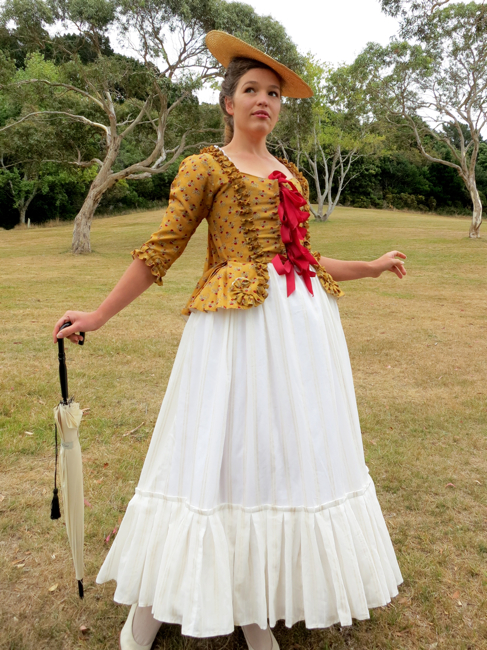
The pet ruffles (particularly the little twists at the front ends) are just delighting me, and the petticoat is much better with the outfit than the old long one I’d paired it with before.
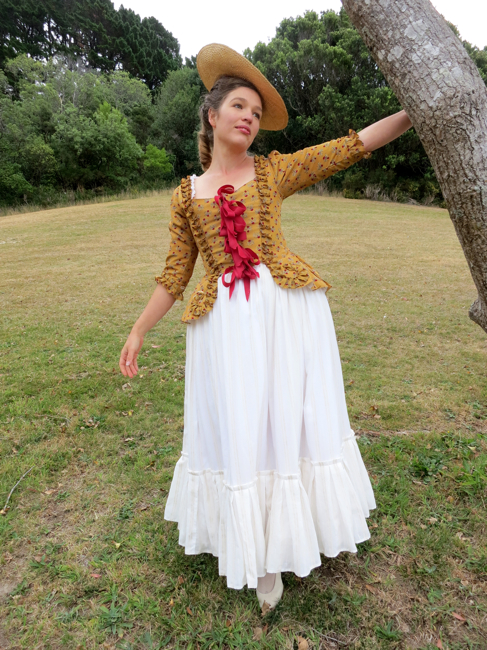
For the photoshoot Madame O and I got dressed up in our respective yellow pet-en-l’aires and headed out to a park for end-of-day photos. It’s been a very dry summer in New Zealand, and the whole country is in varying stages of drought, so the photos are ochre when they would usually be green. It didn’t look much like our usual vision of pretend 18th century Europe, so we just pretended we were in Provence.
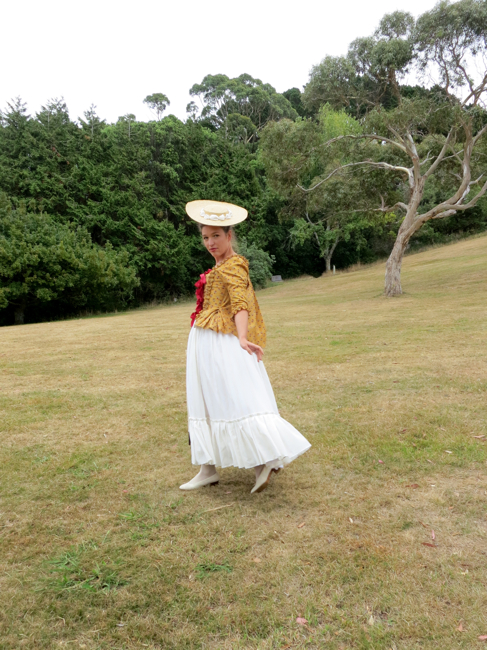
Unfortunately we didn’t see a single other person at the park, so couldn’t get any photos together. Still, she did a beautiful job with mine!

The best part about my new petticoat is that it actually qualifies for HSF challenge: #6 Stripes. The fabric is a bamboo-cotton blend, with the main body of the fabric of cotton, and a bamboo stripe running through it.

No, bamboo certainly isn’t accurate as an 18th century fabric, but this bamboo isn’t as in-accurate as it might be.
There are two ways to process bamboo. The most common is to use chemicals to break down the tough cellulose bamboo fibres. This exactly the same process used to make other cellulose based fabrics like rayon (viscose), and isn’t particularly environmentally friendly. Less common is mechanical processing, which is much more environmentally friendly, but produces a stiffer, more linen-like, fabric. Mechanical processing would have been possible in the 18th century, and produces a fabric which is similar to historical fabrics in its handle and wear. Chemical processing, not so much. Some countries require that bamboo be labelled by the type of processing, but unfortunately New Zealand isn’t one of these countries. Still, based on the hand I am reasonably certain that the bamboo in this fabric was mechanically processed.
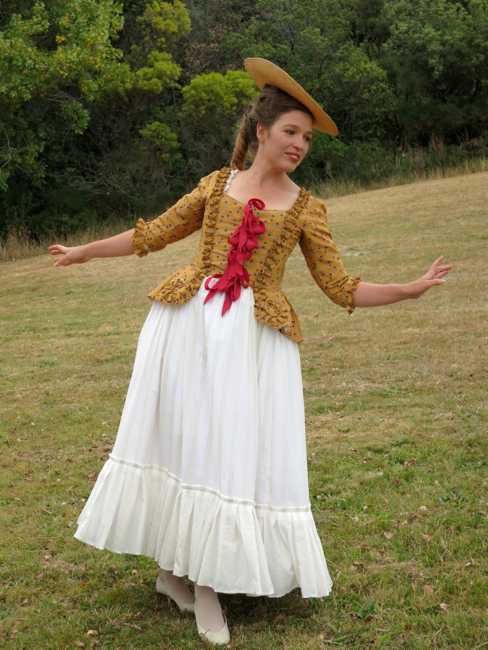
Also, I think I paid $4 a metre for this fabric, and I’ve had it in my stash for 6 years, and I decided to make the petticoat a quickie and machine sew the entire thing, so I’m not too worried about whether it is perfectly historically accurate or not. It’s done, and that’s a thing of beauty in itself!

My bergere hat is another newly finished (though I may trim it further) piece. I remade it from a really dreadful modern straw hat, so I’ll do a post on how to re-make your own straw hat into a bergere in a few weeks as part of the Accessorise challenge. I’ll also tell you a bit more about petticoat construction, for those who appreciate the statistics and details for their own sewing reference
For now, my last two favourite photos. This is naughty Dreamstress throwing acorns at Madame O:
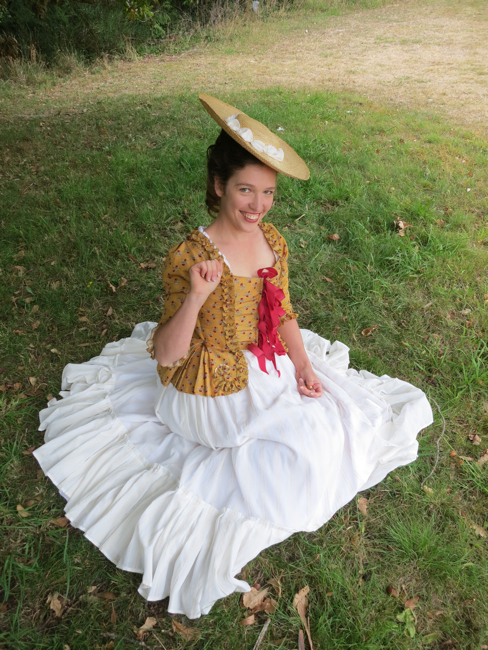
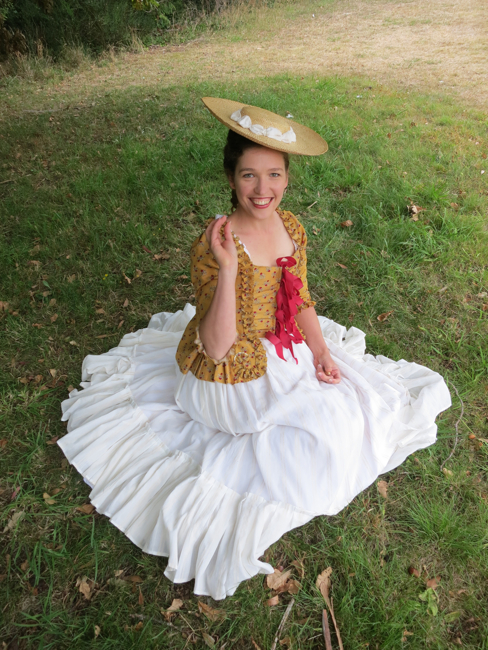
Now how could you be mad at a smile like that?

What a fantastic outfit. It looks amazing. You must be really pleased with it!
Thank you! I am! There are small things I would change with the petticoat if I did it again, but I am pleased to say I think the pet is perfect!
Wow it looks fantastic 🙂
Aww <3 Thank you!
Beautiful! Love the petticoat, mad about the pet. It is a , pity about the crispness of all our greenery, but I like the Provence idea. The acorn photos are charming, but I think I like the demure, ‘sitting in the tree’ one best!
Mischievousness and demure. Both are great. I want to swan around in Provence on a Grand Tour while wearing something so pretty.
Thank you! That’s just how I feel! I like but am perplexed by the ‘sitting in a tree’ one, as it doesn’t look like me! (or at least how I think I look)
Very, very lovely!The pet loogs great, and I also like the petticoat a lot! I didn’t even notice the stripe until you said something, but I like that part, too. The ruffle is also great! By the by, your hair and hat look amazing.
Oh, thank you! I love using very subtly patterned fabrics instead of solid fabrics for coordinates like the petticoat. I feel it adds a little extra interest and dimension to the outfit that many people won’t even consciously notice. It helps things to be neutral without being boring.
And thank you so much for noticing my hair. I fussed with it for so long to get it right. I was hoping to do a ‘hedgehog’, but it just wouldn’t cooperate, so I had to settle for a slightly more old-fashioned hairstyle (though it was still common in the 1780s). Then, when I got home and started taking out my hair I took out four hairpins, and my hair just fell into the perfect hedgehog and stayed there. So frustrating!
This is your most adorable, witty, naughty photo set ever! I love the pet, and the contrast with the petticoat, and the sheer fun of it all.
Oh, so naughty – imagine the scandal of a lady throwing acorns 😉
Thank you!
Pretty! I think this is my favorite out of all the photoshoots you have posted here. The other ruffle-less pet photoshoots just don’t look the same anymore.
I absolutely love the 1780s.
Your hat looks adorable. Actually, the whole outfit looks adorable.
Thank you! Wow…favourite photoshoot!
I completely agree about the other petticoats. Next to this one, they just aren’t cutting it.
Love that curl!
The skirt!
The hat!
The smile!
Thank you and thank you and thank you and thank you 🙂
It’s absolutely beautiful, and I love the new petticoat/hat combo to go with.
Thank you Cari! I’ll be doing a tutorial on how to make the hat in a week or so.
Oh yes, that petticoat is excellent. As always, you look gorgeous in the photoshoot!
Thank you Stella!
I carefully edit out all the photos where I don’t look gorgeous 😉
It’s a very cute outfit!
Thanks!
Absolutely charming!
Thank you Catherine!
And naughty sounds very 18th century.
Don’t idealise Europe, by the way. We do get our dry, yellow grass days, too.
I’m not sure that 18th century naughty involved a lot of ladies having acorn fights 😉 It might have been more fun if it did though…
I imagine there are parts of Europe (Provence, as I noted) that do get dry, and of course sometimes you do have dry summers and droughts, just as we are, but I’ve always envisioned these fashions as the provenance of damp, green England, and swampy Versailles. Slightly ridiculous of me of course – clothes were worn everywhere!